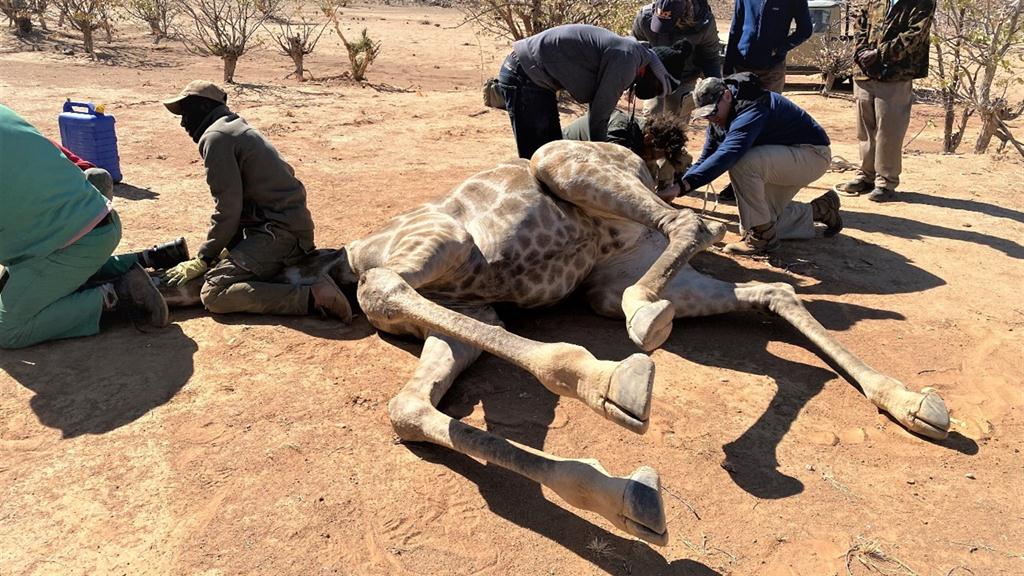GPS monitors keep giraffes’ tails wagging
Fitting giraffes with tracking devices is no simple task, as the animals do not tolerate sedation well.
ELLANIE SMIT
WINDHOEK
Four new satellite GPS telemetry units were fitted to giraffes in the Etosha National Park and Ehirovipuka Communal Conservancy recently.
The monitors were placed on the giraffes’ tails instead of their horns, where they are usually placed.
This was done by the Namibia University of Science and Technology’s (NUST) Biodiversity Research Centre (BRC), in collaboration with the environment ministry, the Giraffe Conservation Foundation (GCF) and the University of Namibia’s (Unam) School of Veterinary Medicine.
The exercise was done under the auspices of the ORYCS project, a Namibian-German research project in collaboration with Potsdam University.
“Namibia is one of the few places where giraffes are adequately protected and their numbers are growing. Therefore, understanding their movements, what they eat and how they react to human encroachment can be used for their global protection,” Morgan Hauptfleisch, the BRC head and associate professor from NUST’s faculty of natural resources and spatial sciences, said.
Due to their unique physical structure, it is not a simple task to fit GPS monitors on giraffes.
The GCF was the first to use GPS satellite units and have been evolving them for the last 20 years.
“In July, NUST and GCF tested a new device that can be attached to the tail of the giraffe. This could replace the previous technology which is fitted to the horn of the animal,” Hauptfleisch explained.
In the past, research showed that horn GPS devices got damaged on a regular basis when giraffes fight, and in general, the process of fitting the device was a lengthy one.
“The tail units take a minute, at most, to fit, and since this species does not respond well to anaesthetics, we need to get the animal back on its feet as quickly as possible,” Hauptfleisch elaborated.
Helpful information
The device provides information on the feeding requirements and preferences of animals, and identifies obstacles to migration and possible sites of human-wildlife conflict.
Giraffes are widely spread across Namibia, occurring in national parks, private land as well as communal land.
Giraffe numbers and distribution in Namibia have increased over the past 30 years due to well-managed conservation efforts.
Based on a recent survey by the Giraffe Conservation Foundation, it is estimated that there are approximately 12 100 giraffes in the country - 6 500 on private land, 2 000 on communal land, and 3 600 in national parks.
WINDHOEK
Four new satellite GPS telemetry units were fitted to giraffes in the Etosha National Park and Ehirovipuka Communal Conservancy recently.
The monitors were placed on the giraffes’ tails instead of their horns, where they are usually placed.
This was done by the Namibia University of Science and Technology’s (NUST) Biodiversity Research Centre (BRC), in collaboration with the environment ministry, the Giraffe Conservation Foundation (GCF) and the University of Namibia’s (Unam) School of Veterinary Medicine.
The exercise was done under the auspices of the ORYCS project, a Namibian-German research project in collaboration with Potsdam University.
“Namibia is one of the few places where giraffes are adequately protected and their numbers are growing. Therefore, understanding their movements, what they eat and how they react to human encroachment can be used for their global protection,” Morgan Hauptfleisch, the BRC head and associate professor from NUST’s faculty of natural resources and spatial sciences, said.
Due to their unique physical structure, it is not a simple task to fit GPS monitors on giraffes.
The GCF was the first to use GPS satellite units and have been evolving them for the last 20 years.
“In July, NUST and GCF tested a new device that can be attached to the tail of the giraffe. This could replace the previous technology which is fitted to the horn of the animal,” Hauptfleisch explained.
In the past, research showed that horn GPS devices got damaged on a regular basis when giraffes fight, and in general, the process of fitting the device was a lengthy one.
“The tail units take a minute, at most, to fit, and since this species does not respond well to anaesthetics, we need to get the animal back on its feet as quickly as possible,” Hauptfleisch elaborated.
Helpful information
The device provides information on the feeding requirements and preferences of animals, and identifies obstacles to migration and possible sites of human-wildlife conflict.
Giraffes are widely spread across Namibia, occurring in national parks, private land as well as communal land.
Giraffe numbers and distribution in Namibia have increased over the past 30 years due to well-managed conservation efforts.
Based on a recent survey by the Giraffe Conservation Foundation, it is estimated that there are approximately 12 100 giraffes in the country - 6 500 on private land, 2 000 on communal land, and 3 600 in national parks.




Comments
Namibian Sun
No comments have been left on this article